The numbers are in for 2020.
Remember Greta Thunberg, the girl who can’t quit, said:
- The emissions are increasing and that is the only thing that matters.
In September 2019 I posted the Four graphs that matter in the climate emergency with some bonus graphs. I’ve decided that we should be watching sea level rise also, because of the future destruction it will wreak, and because sea level rise was the chief motivation behind the move from the island states to target 1.5°C of warming rather than 2°C.
The big news, however, is that 2020 was basically tied with 2016 as the warmest year ever, which is now reckoned to be 1.25°C or more above pre-industrial, depending on where you start.
I’ll do the graphs in the same order, inserting sea level rise at number 4:
-
1. Greenhouse gas emissions
2. Ocean heat content
3. Global surface temperature
4. Global sea level rise
5. Global energy consumption by source.
1. Greenhouse gas emissions
The monthly average at Mauna Loa for CO2 came in at 414.02 ppm in December 2020, compared to 411.76 in 2019, so COVID 19 made no dramatic difference at all.
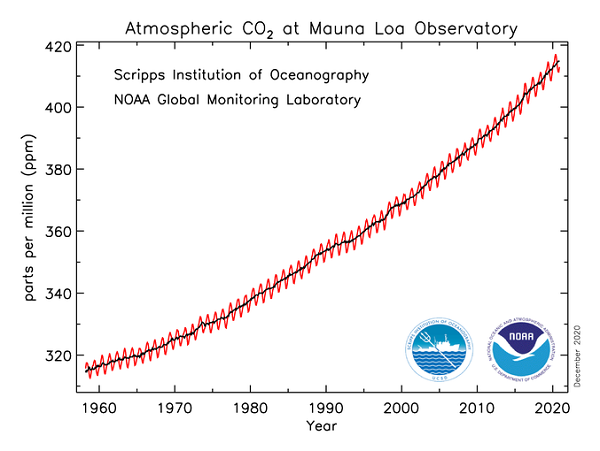
To explain, people may have been encouraged by reports that emissions were down by 7%, but that only means that the last saw tooth was 7% smaller than it was in 2019, which is not noticeable on the graph. The emissions that Greta Thunberg is watching and worrying about are still going up. That graph won’t flatten until emissions are well on the way to zero.
Of course CO2 is but one of the ‘Kyoto six’, but roughly 80% of the problem. Hansen et al Global temperatures for 2020 post this interesting graph:
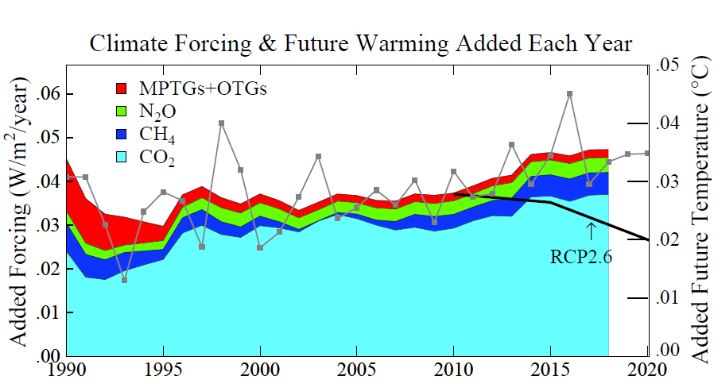
It shows the future warming effect for each greenhouse gas each year. The red band (MPTGs are Montreal Protocol Trace Gases and OTGs are Other Trace Gases) shows the beneficial effects of the Montreal Protocol on Substances that Deplete the Ozone Layer of 1989. The RCPT2.6 line shows where we should have been heading if we had headed for 1.5°C when the Representative Concentration Pathway scenarios were developed by the IPCC.
2. Ocean heat content
Roughly 93% of the added heat goes into the ocean. In Damien Carrington’s piece Climate crisis: record ocean heat in 2020 supercharged extreme weather he reports that the extra heating is equivalent to the detonation of about four Hiroshima-style atomic bombs per second. So the heat stored in the ocean is massive and builds up inexorably:
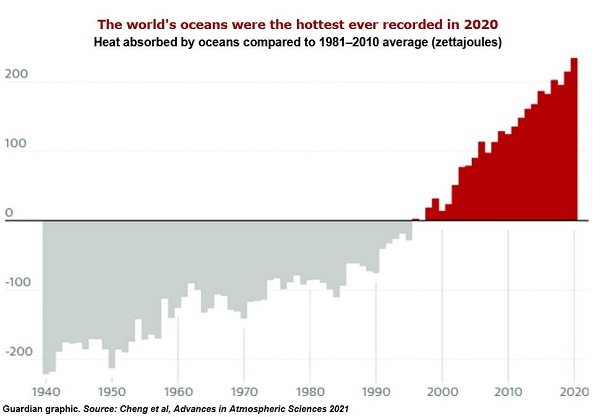
Rather than use the 1980-2010 baseline, this one starts from 1960, gives the layering and the error bar.
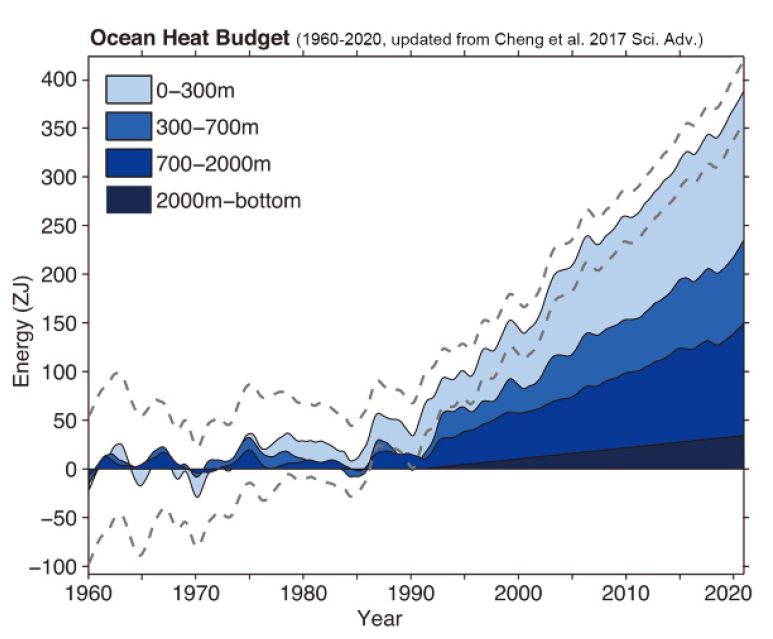
If we reach zero emissions, ocean heat will remain, but some may move to other parts of the earth system to exacerbate the warming already taking place there:
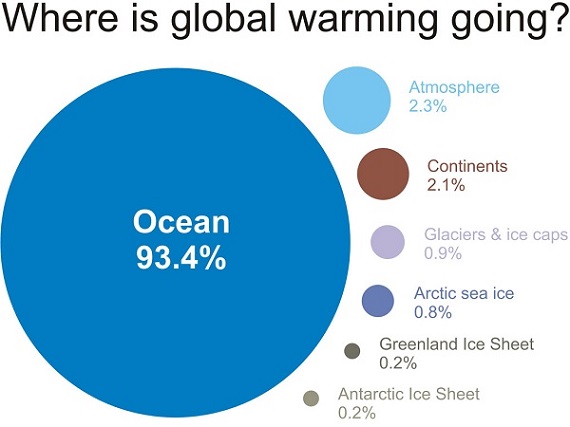
In particular, there is a concern that warmer water is in direct contact with ice sheets.
See also Climate change pushed ocean temperatures to record high in 2020, study finds.
3. Global surface temperature
Jeff Masters reports that NOAA names 2020 second-hottest year on record; NASA says it tied for hottest ever. All the institutions in the business have 2020 roughly equal to 2016 as the hottest year on the instrumental record.
I like the Hansen et al Global temperatures for 2020:
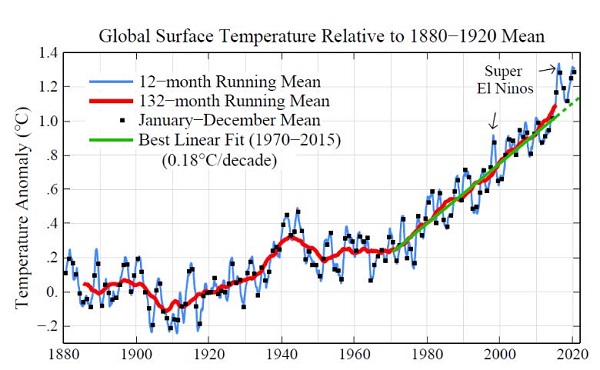
This shows a remarkable trend from about 1970, then a move above trend in the past six years. Up to 2014 decadal warming had been almost constant at about 0.18°C/decade.
Hansen et al use NASA data, with 1880-1920 as the base period on the grounds that reliable records date from about 1880. That make warming +1.3°C warmer than in the 1880-1920 base period, a little warmer that the commonly cited +1.25°C.
Gavin Schmidt at RealClimate provides a graph showing the underlying warming when the ENSO effect is taken out:
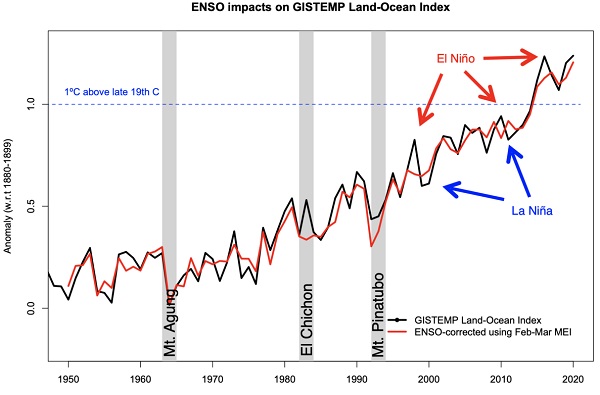
So the strong El Niño in 2016 pushed the temperature up. In 2020 the temperature roughly equalled 2016 in spite of a developing La Niña. However, the strongest effect of a La Niña comes about three or four months after the ocean cycle peaks, so the full effect won’t be known until next year. The underlying trend will also be confirmed or denied by the years ahead, but the direction is worrying.
The Northern Hemisphere was clearly warmer than the Southern Hemisphere:

So why is it so cold so far south in the NH this winter?
It’s about the jet stream and polar vortex which has been behaving increasingly erratically:
-
Some recent cold spells have been caused by a dreaded weather system called the polar vortex. There’s growing evidence to suggest that the polar vortex is appearing outside the Arctic more frequently, because of changes in the jet stream that are attributed to the warming atmosphere. These changes help frigid air escape from the Arctic and swoop southward.
At the same time, the Arctic is warming three time faster than the rest of the planet.
Andrew Glikson (see below) keeps saying that the aerosols created by burning fossil fuels suppress the temperature by about 0.5°C, which would mean that with zero emissions 1.5°C would be impossible to avoid.
4. Global sea level rise
The CSIRO/BOM State of the Climate 2020 has a graph showing sea level rise:
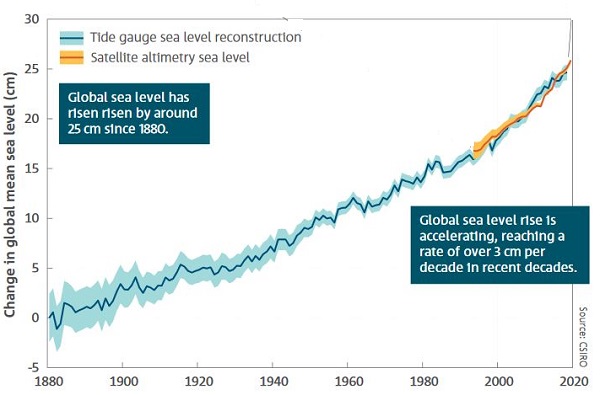
Haley Dunning in Ice sheet uncertainties could mean sea level will rise more than predicted quotes John Englander, President and Founder of the Rising Seas Institute:
- “Sea-level rise will be one of the most challenging issues faced by society in the coming decades. We need to recognize that we cannot stand by and wait for clarity about actual sea-level rise to begin planning for it.
“Waiting for better confidence in predictions is not a reason to delay building a margin of safety, for example into building codes and zoning, recognising the inevitability of sea-level rise and its catastrophic implications.”
Englander was a joint author of a paper by Martin Siegert et al Twenty-first century sea-level rise could exceed IPCC projections for strong-warming futures where they point out that the IPCC language on sea level rise, implying that 1.1 metres is the upper bound for 2100, has been problematic. The IPCC’s use probability language in a defined and consistent way, so in the IPCC’s terms:
- future sea-level rise under 4°C warming is likely in the 0.6 to 1.1 m range, it means that there could be a 1 in 3 chance that reality falls outside the reported range.
Siegert et al point out that the risk is on the upside, not on the lower side.
Englander also points out that the graph is bending upwards:

That was from a CBSNews article citing Englander. Then in Englander’s Our New Paper Raises the Sea Level “bar”:
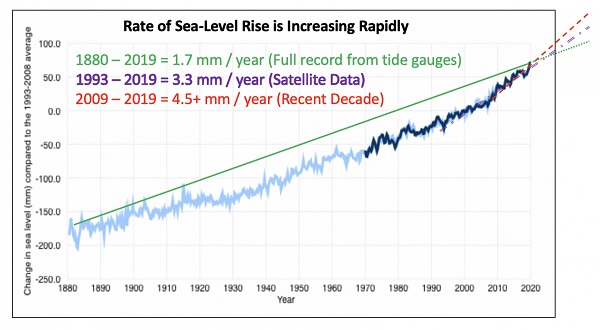
James Hansen’s nightmare was that if the ice sheets are genuinely in play we could see doubling of the rate of sea level rise every 10 years, which could have given us 5 metres by 2100. That looks unlikely now, but we still thinks multi-metre sea level rise is possible.
Andrew Glikson in his latest book The Event Horizon: Homo Prometheus and the Climate Catastrophe reminds us that the last time emissions were over 400 ppm was in the Pliocene, when the temperatures were 2-3°C higher than pre-industrial, and sea levels were higher by 25m, plus or minus 12.
More to the point, however, Glikson is a paleoclimatologist who sees that the current forcing of the climate is 30 times stronger than it was coming out of the last ice age, when we got 4.5°C warming and 120m of SLR in about 7,000 years. Glikson says current forcing is more than 10 times stronger than 10 times stronger than in the Paleocene–Eocene Thermal Maximum event, which saw temperatures increase by 5-8°C over 20,0000 to 50,000 years. To Glikson we have to go back to the so-called KT-Extinction of 66m years ago for a comparable earth system disruption, which finished off the dinosaurs along with three-quarters of the plant and animal species on Earth.
So Glikson sees global warming from the beginnings of the industrial age to when we reach zero emissions as a single event with cataclysmic effect.
We can hope he is wrong, but we may be at an event horizon where there is no return.
Before all that, in 2017 we had the final draft of the U.S. GLOBAL CHANGE RESEARCH PROGRAM CLIMATE SCIENCE SPECIAL REPORT, which I suspect was never finished because Donald Trump cut off the funds. It’s a kind of mini-IPCC report with special emphasis on the USA. It says two things of relevance here.
Firstly, it says we definitely do not know what is going to happen in the next century.
Secondly, it says that the IPCC pays too little attention to paleoscience, and that sea level rise of 2.4 metres by 2100 is possible.
Policy makers need to understand that all those numbers are global averages. Irwin Lambert and colleagues have now found that Correlations between sea‐level components are driven by regional climate change. In simple terms, any policy maker in a country, state, city of local government area cannot use global averages to infer what will happen in their jurisdiction. The system is complex and interactive, so local results can be above or below global averages, even if the global average forecasts are correct, which is unlikely.
So articles like Victoria gets trillion-dollar bad news: sea level rises will swamp parts of the state miss the point.
It seems building new living spaces near the sea is very popular. So the possibility of lifting the current legal SLR constraint from 0.8 metres to 1.1 metres for building approvals is causing major conniptions. Policy makers, capitalists and people in general should realise that in terms of risk the IPCC numbers, if they were ever intended to be used like that, are seriously low-balled, and are in any case useless for any given region.
Stay well away from the sea, or head for the hills!
By the way, the Chinese have a humungous problem (see Rising Seas Threaten China’s Long, Low, and Crowded Coast). They have plans expand coastal sea walls to 15,000 kilometers in length, plus 32 cities including Shanghai are experiencing subsidence from groundwater exploitation.
We will watch with interest to see whether they find that reducing atmospheric GHGs and cooling the planet may be preferable to building defences.
5. Global energy consumption by source.
As Greta Thunberg said, emissions are increasing and that is the only thing that matters. The reason why is not hard to devine. Hansen et al give this graph of Global energy consumption by source:
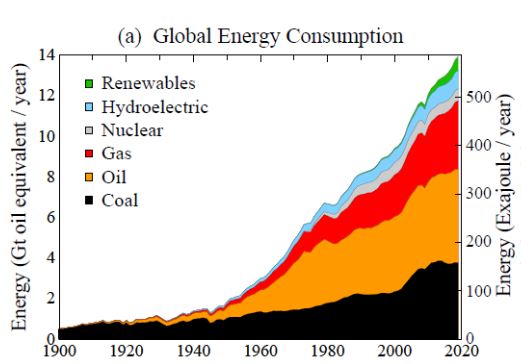
We properly celebrate and are heartened by the progress of renewable energy. The bottom line, however, is that fossil fuel use is increasing too.
Gas has been touted as having half the effect of coal. Without addressing this fallacy at length, Adam Bandt says gas is just as dirty as coal. ABC has done an extensive factcheck.
We can argue the toss at length, but the bottom line is that that the planet can’t afford us burning gas, oil or coal, without offsetting to make them carbon neutral, which in most cases is too expensive.
To get sea level down and to alleviate all the other adverse impacts of global warming, we need temperatures down, so we need airborne greenhouse gases to come down. We need to turn down the dial controlling global warming.
At least since 2013 I have been recommending we reach zero emissions by 2030, and then draw down emissions to reach 350 ppm as soon as possible. 2020’s graphs mean that if anything we should increase that ambition, not shunt it on into the future.

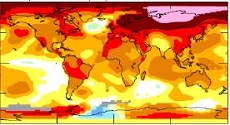
In recent days, we have had the National Party come out arguing for new coal-fired power.
Overnight, in order, I heard three separate happenings.
First, (Sir) Twiggy Forrest giving a truly mind-blowing talk wherein he plans to green his company by 2030, and build green hydrogen facilities in the Pilbara to make steel and pipe green energy to Singapore. 40,000 jobs, he reckons, and of the type that would suit former coal industry workers.
Next week he’s going to tell us how to clean up the oceans.
Second, we had news that Mark Butler is going to get the flick in the ALP shadow cabinet, so that Chris Bowen can take over, and recalibrate Labor plans to be more coal-worker friendly.
Joel Fitzgibbon is pleased, so it looks as though shadow cabinet will remain in the shadows after the next election.
Third, Will Steffen has chaired a group including John Hewson, which has taken a look at what our responsibilities to the Paris agreement. Unsurprisingly, they find the need to up the ante, not stuff around.
I’ll have to find some links.
Brian: Renew Economy definitely not impressed by the Butler move: “Butler dumped as Labor’s climate opposition collapses at a truly pivotal moment” https://reneweconomy.com.au/butler-dumped-as-labors-climate-opposition-collapses-at-a-truly-pivotal-moment/
“It’s odd how climate news tend to rhyme and counter itself across the world in perfect unison. Joe Biden has just announced a huge raft of major new climate policies, after coming to power off a campaign that focused heavily on climate. It’s a big moment, and it’s being received well by both the American energy industries and by the progressive activists that helped shape Biden’s policies.
Back in Australia, the news that opposition climate spokesman Mark Butler is losing the climate change portfolio to a member of the party’s right wing was leaked to media. What a contrast. As the federal government sinks even deeper into a climate and energy funk, the opposition marks this major global climate moment by sacking one of their best.”
What do you have to say?
John, my heart fell through the floor when I heard Joel Fitgibbon carrying on the morning.
However, Albo had to do something, and what he has done is better than nothing. I’ll say more later.
Just to elaborate a bit, Albo was caught with an ascendant ScoMo, the media were onto him, and his colleagues started to wake up in fright.
You will recall late last year he went to a factory in Glenelg, I think, and there was only one photographer there.
He had to do something, and Fitzgibbon’s resignation provided reason and excuse for shuttling the ministry.
If you look at each move he has made there is reason behind it and it may strengthen policy and/or communication in that area.
Leaving aside Fitzgibbon and a small ginger group, there is no difference between Right of Left or anyone in the cabinet on climate change. Albo said people could think what they liked about Fitzgibbon, but his shadow cabinet was solid on climate. Basically he was saying Fitzgibbon is irrelevant.
there has been no policy change. He said that zero by 2050 was definite and there would be consideration of a 2035 target when policy was determined after the National ALP conference.
Meanwhile, he said climate was an economic portfolio (green new deal kind of stuff), so it was appropriate to put an economist in charge. Bowen and Butler are good mates, so no problems.
Butler has been minister for the aged and has written a book about it, and has a special interest in mental health.
I hope someone teaches Chris Bowen a few media skills. He was good when he was interim leader that time in 2013 but sometimes seems a bit slack.
Jason Clare remains asst minister, climate change, he also has responsibility for Pacific island affairs. Every time I’ve heard him he has been excellent.
However, the election is probably ScoMo’s to lose, unless people wake up to how slippery and useless he is.
John, have a listen to Chris Bowen on RN Breakfast this morning. I thought he was good.
Albo also said he welcomed Zali Steggall’s bill.